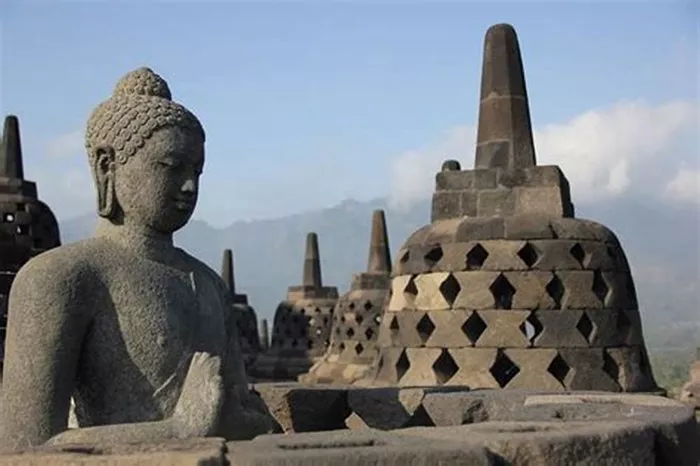Enlightenment, or Nibbana (Nirvana), is the ultimate goal in Theravada Buddhism. It means freedom from suffering and the cycle of birth and death, known as samsara. When someone becomes enlightened, they fully understand the true nature of reality. They no longer crave or cling to anything, and this ends all suffering.
The Path to Enlightenment
In Theravada Buddhism, enlightenment is achieved by following the Noble Eightfold Path. This path includes right view, right intention, right speech, right action, right livelihood, right effort, right mindfulness, and right concentration. By practicing these steps carefully, a person gradually cleans their mind from defilements like greed, hatred, and ignorance.
Who Can Be Enlightened?
Anyone Who Truly Practices
Theravada Buddhism teaches that enlightenment is possible for anyone. It is not limited to monks or special people. If a person sincerely follows the Buddha’s teachings and practices the path, they can reach enlightenment. This means that laypeople, women, men, and monks all have the potential to become enlightened.
The Four Stages of Enlightenment
Theravada Buddhism describes four stages on the path to full enlightenment:
- Sotapanna (Stream-Enterer): A person who has entered the stream leading to enlightenment. They have weakened the first three fetters that bind beings to samsara.
- Sakadagami (Once-Returner): Someone who will return to the human world only one more time before full enlightenment.
- Anagami (Non-Returner): A person who will not return to the human world but will be reborn in a higher realm and reach enlightenment there.
- Arahant: A fully enlightened being who has eliminated all defilements and will not be reborn again.
Anyone who progresses through these stages is moving closer to full enlightenment.
Monks and Laypeople
In Theravada Buddhism, monks are traditionally seen as having the best conditions for enlightenment. This is because they can fully focus on the practice without many distractions. However, the teachings do not exclude laypeople. Many lay followers can also become enlightened by living a moral life, meditating, and developing wisdom.
Women and Enlightenment
Theravada Buddhism recognizes that women can achieve enlightenment just like men. Historically, there were many enlightened nuns and laywomen. The Buddha accepted women into the monastic order and taught them the path to enlightenment. Thus, enlightenment is not gender-specific.
Conditions Needed for Enlightenment
Strong Determination and Faith
One important factor for enlightenment is strong determination to practice sincerely. Faith in the Buddha, the Dhamma (teachings), and the Sangha (community) supports this effort. Without faith and resolve, progress on the path is difficult.
Moral Conduct (Sila)
Moral behavior is the foundation for meditation and wisdom. Without ethical conduct, the mind cannot calm down or concentrate. The Five Precepts for laypeople and the Vinaya rules for monks help keep moral discipline. This discipline makes it easier to remove mental impurities.
Meditation Practice
Meditation is essential to develop mindfulness and concentration. Through meditation, practitioners observe their mind and body, understand impermanence, suffering, and non-self, and gradually uproot ignorance and attachment.
Wisdom (Panna)
Wisdom is the clear understanding of reality as taught by the Buddha. It includes insight into the Four Noble Truths and the Three Marks of Existence: impermanence, suffering, and non-self. Wisdom grows through study, reflection, and meditation, and it is crucial for enlightenment.
Obstacles on the Path to Enlightenment
Attachment and Craving
Attachment to worldly things and desires binds beings to suffering. Overcoming craving is a major challenge on the path. Meditation and mindfulness help weaken these attachments.
Ignorance
Ignorance is the root cause of suffering. It means not seeing things as they really are. Developing wisdom and practicing the teachings gradually dissolve ignorance.
Distractions and Laziness
Daily life distractions and laziness can stop people from practicing consistently. Perseverance and strong determination are needed to overcome these obstacles.
Examples of Enlightened Beings in Theravada Buddhism
The Buddha
The historical Buddha, Siddhartha Gautama, is the supreme example of enlightenment. He showed the path and taught others how to reach the same goal.
Arahants
Many of the Buddha’s disciples became arahants. These are fully enlightened beings who have completely freed themselves from suffering. Their lives demonstrate that enlightenment is achievable.
Lay Enlightened Practitioners
There are records in Theravada texts of laypeople who became enlightened. Their examples prove that monks are not the only ones who can reach this state.
Who Can Be Enlightened?
Key Points to Remember
- Enlightenment is the goal of Theravada Buddhism, meaning full liberation from suffering.
- Anyone who sincerely follows the Buddha’s teachings can become enlightened.
- The path involves moral conduct, meditation, wisdom, and strong determination.
- Enlightenment is open to monks, laypeople, men, and women.
- The Four Stages of Enlightenment mark progress toward full awakening.
Conclusion
In Theravada Buddhism, enlightenment is not a secret reserved for a few. It is the potential of every being who walks the path with sincerity. By practicing ethical living, meditation, and developing wisdom, anyone can free themselves from suffering and realize the true peace of Nibbana.

